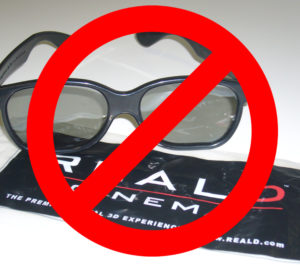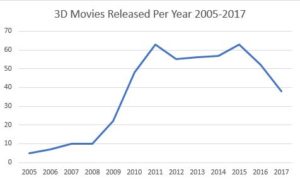IMAX, 4k, Ring the Death Knell for 3D
 by Arnie Carvalho
by Arnie Carvalho
Did James Cameron wait too long for his Avatar sequels? It seems that by the time Avatar 2 is released (optimistically scheduled for 2020) the 3D format utilized by that 2009 original may be a thing of the past.
IMAX Announces 2D “Preference”
IMAX CEO Richard Gelfond announced this week that the company will be reducing the number of 3D screenings on their high-priced, large format projectors and screens. He cited a “clear preference” from North American audiences for 2D films.
This statement of direction does not signal an abrupt shift. IMAX’s most recent release, Christopher Nolan’s Dunkirk, was filmed and released only in 2D. (Nolan has a history of disliking the 3D format, refusing Warner Bros’ requrest for his Dark Knight films to be released in the format which commands a higher ticket price.) Before that, the 3D post-converted Spider-Man: Homecoming was shown on IMAX screens in a combination of 2D and 3D presentation. This is a change from even a year ago when most IMAX viewings required the audience to don a pair of special, plastic glasses.
This follows a recent history of movie-goers intentionally choosing 2D presentation and falling 3D ticket sales.
Home Video Flattens Out
It’s not only in theaters that 3D is dying. Movie viewers also have shown a preference for the 2D picture in their homes. In 2010, riding off Avatar’s success, High Definition Blu-Ray discs started shipping in 3D formats (the first of which was Cloudy with a Chance of Meatballs). 3D features were included on all high-end 1080p televisions and home projectors.
However, with the recent advances in 4k resolution, 3D has become a feature of the past. Over the past few years television manufacturers like Sony and LG have phased out 3D capabilities on most of their 4k televisions. With their 2016 models LG only offered 3D on their curved television sets; in 2017 3D was removed altogether. Likewise 4k home projectors are removing support for 3D, with only Sony offering true 4k projectors that are backwards-compatible with the 3D Blu-Ray format.
Indeed, there is no established standard for 4k home video content to be displayed in 3D; currently movie buyers must choose between the higher resolution or the greater depth in their films.
Is this a win for consumers?
These changes follow the standard market practice of meeting consumer demand.
The 3D format has long been rife with viewer complaints. In addition to being forced to wear glasses to watch 3D content, be it in theaters or at home, many viewers could not appreciate the added dimension. Per vision insurance company VSP, 5% of the population cannot percieve 3D, and another 25% have trouble perceiving 3D images. Another 25% or more have complained of headaches, eye strain, and eye fatigue from current 3D digital projection.
These complaints have gotten many people to buy special “2D Glasses” which allow them to see (non IMAX) 3D films in 2D format. (Now Playing Podcast host Marjorie can vouch for these glasses’ effectiveness.)
Many theater-goers also complained about the unreliable quality of 3D in films, much due to the post-conversion process many studios use to save money. The vast majority of 3D films were post-converted–in 2017 only Transformers: The Last Knight was shot natively in the 3D format. On Now Playing Podcast we have complained about lackluster 3D in Spider-Man: Homecoming, War for the Planet of the Apes, Pirates of the Caribbean: Dead Men Tell No Tales, and other movies.
Hollywood studios fought this trend. Many studios intentionally limited 2D availability of films, including 2012’s Prometheus, in order to reap higher profits from the inflated ticket prices.
Will this hurt studios?
Yet despite these consumer complaints, studios have continued to push the 3D format, which commands higher ticket prices. As movie budgets continue to expand, the higher priced 3D tickets, IMAX tickets, and other “premium” theater experiences have bolstered studio bottom lines. More, the 3D Blu-Rays sell for $30 or more, while their 2D counterparts are often half that. (Of note, the higher-resolution 4k Blu-Ray discs are often priced equal to, or higher than, their 3D counterparts.)
While the 3D Post Conversion can add $10 million or more to a film’s cost, the increased revenue often offsets that. Many older films, including Jurassic Park and Top Gun were post-converted and re-released to theaters to grab their studios a quick buck.
Yet this switch back to 2D may not bring cheaper ticket prices. AMC Theaters charges the same for 2D and 3D IMAX screenings. It’s possible theaters may raise all ticket prices to current 3D prices to help offset these losses. Also, studios and theater chains have discussed having “event movie” pricing, where tickets cost more for big-budget blockbusters with or without “premium” gimmicks like 3D.
No change for animation?
The movie format that has generated the greatest 3D success is kids’ fare and computer-animated movies, such as LEGO Batman and Moana. As these films are entirely computer-generated the 3D is more ingrained in their development. The effects are better, and the audience for those films are primarily younger and not yet burnt-out by the format. While Gelfond made no specific mention of animated films staying in 3D, it is likely these will remain in that format for years to come.
Modern 3D History
The modern 3D era was brought in by Cameron in two waves. In 2003 the first modern, digital 3D film was his IMAX documentary Ghosts of the Abyss. The format had a slow growth over the next six years, mostly as a gimmick in kids films including Spy Kids and The Polar Express.
The change to 3D was a clumsy one. Superman Returns and Harry Potter and the Order of the Phoenix both had select scenes converted to IMAX 3D–requiring customers to don and remove

Source: https://en.wikipedia.org/wiki/List_of_3D_films_(2005_onwards)
glasses through the films.
Modern 3D came into its own in 2009. By that time the 3D cameras required had come down in price. Horror films (which had heavily relied on 3D in the ’80s) got into the game with My Bloody Valentine 3D and The Final Destination. Animated films premiered in the format, including Coraline, Monsters vs. Aliens, Ice Age: Dawn of the Dinosaurs and Cloudy with a Chance of Meatballs.
But Cameron ushered in a new age with the 3D film Avatar. Somewhat bolstered by 3D and IMAX ticket prices, Avatar became the top-grossing film of all-time. This created a 3D “gold rush” among studios, exponentially increasing the quantity of 3D films produced.
This growth continued until 2011, when 63 3D movies were released. Growth then leveled off through 2015, when the number of films started to decline.
With these changes to home video and IMAX formats, it is likely 3D films may return to their pre-Avatar numbers.
What do we lose, besides depth?
I’m no great fan of 3D. However, as a movie-goer who prefers to see the movie as the director intended, I’m slightly upset by the loss of the 3D home format. Every movie I’ve purchased since 2010 has been in 3D, if available. I was especially happy with the Transformers films which not only were released in 3D but also changed to the IMAX aspect ratio for their home video releases.
I remember growing up watching movies like Friday the 13th Part III, Jaws 3-D, Emmanuelle 4, and Freddy’s Dead: The Final Nightmare on video. All three films had 3D components in theaters which translated poorly to television. The moments of “I can tell that should be 3D” worsened each viewing experience.
I recently purchased my first 4k TV and had to go through great pains to find one that would continue to support my 3D Blu-Ray discs. It seems in the next five years any movie with great 3D, such as Avatar, Tron: Legacy, and X-Men: Apocalypse will only be seen in their flattened versions.
Even movies filmed in 2D, such as Star Wars: The Force Awakens and Guardians of the Galaxy Vol. 2 had effects sequences specifically designed in 3D to showcase the technology.
Home movie viewers will lose the ability to view many movies from the past decade as they were intended to be seen.
Final Thought
But overall, I believe 3D is a gimmick that more than ran its course. I applaud IMAX for choosing consumers over studios, and I hope that filmmakers now focus on plot and character depth, instead of manufactured depth on the screen.
What do you think? Sound off in the comments!
July 28, 2017 - Posted by Arnie C | Movies, News | 3D, 4k, Enertainment, Film, IMAX, Marvel, Marvel Cinematic Universe, Marvel Comics, Movie, Movies, News, Now Playing, Now Playing Podcast, sci-fi, Spider-Man, Star Wars, X-Men
5 Comments
Sorry, the comment form is closed at this time.
-
Archives
- February 2021 (1)
- January 2021 (1)
- December 2020 (1)
- November 2020 (3)
- October 2020 (2)
- September 2020 (1)
- August 2020 (2)
- July 2020 (1)
- June 2020 (1)
- May 2020 (1)
- April 2020 (3)
- March 2020 (2)
-
Categories
-
RSS
Entries RSS
Comments RSS
Site info
Venganza Media GazetteTheme: Andreas04 by Andreas Viklund. Get a free blog at WordPress.com.

I’ll miss it a little bit because the physical act of putting on 3d glasses made movies “special”/associated with…but the actual effects are meh…I must fall into a % category of people who have a hard time noticing because after 20 minutes…it all looks flat to me…unless it’s a guy stabbing the screen with a pitchfork.
Just wanted to say Now Playing is awesome…thanks for doing it. If I were a Saudi shiek I’d give you guys millions.
In my opinion 3d could have been a lot better the earliest 3d films i actually enjoyed watching at the cinema were fly me to the moon and journey to centre of the earth as rather than depth these had 3d effects coming towards to viewer causing audience to sometime even react to this effects giving a more interactive experience however i feel but i have no evidence to support this that this effect rather than depth was either costing more or taking more time to film therefore not the cheaper option. Neither of these films were released on true blu ray 3d. I have a 3d tv at home and have extensive 3d movie collection imported from australia that i can watch due to not being region locked i am disappointed that the day will come when my 3d tv will either break or become obsolete therefore i wont be able to enjoy this great films in their 3d format
In my humble opinion, I’m glad IMAX is going back to 2D! I remember my experience watching “Mission Impossible: Rogue Nation” and thanking God that not only was it showing in IMAX, but 2D as well. To me personally the 3D adds nothing to the story or excitement of a film, it’s just gimmicky. I’ve often passed on IMAX screenings if they were in 3D and wishing they had a 2D IMAX option as well.
Hollywood shot themselves in the foot with all the post conversion nonsense. That’s why people associate 3D with headaches and eye fatigue. A TRUE 3D movie has to be shot a specific way (with subtle differences in framing) and on a specific type of camera to ensure the lack of headaches and eye fatigue. Not only should there be two lenses on a 3D camera (one for each eye) but the space between those lenses should depend upon how far away the subject is that you’re shooting. A cinematographer should measure the distance between the camera his subject, then do a mathematical conversion that correlates to how far apart the lenses are set. Post conversion (just to have an excuse to jack up prices) is responsible for most of the anti-3D sentiment. Hollywood’s greed is killing 3D.
I’m sad to see 3D leaving the home theatre systems. I have been a 3D fan since I saw Jaws 3D and Friday The 13th 3-D in the theatres back in 1984, and just love the 3D experience. It’s a gimmick – no doubt about that – and not a gimmick for everyone, but I love it. Sadly it seems that whenever my current 3D TV burns out, I won’t be able to replace it (even though Playstation VR might be the sollution).
I blame the film companies for putting out crappy product, and I’m not even pointing at Hollywood, because many of the independent 3D productions have been just as bad as some of the Hollywood stuff (if you don’t believe me, check out Nurse 3D, Night of the Living Dead 3D or Scar 3D). Most people are annoyed by the 3D glasses already, and burning them with bad product has not helped 3D’s status…